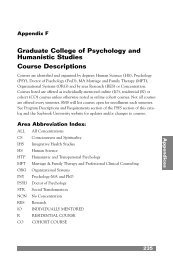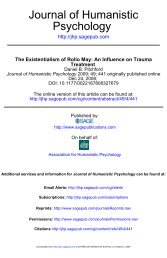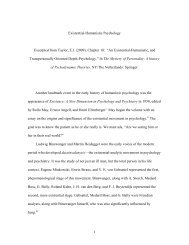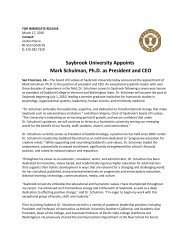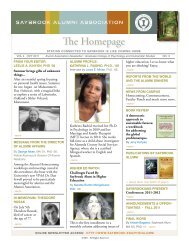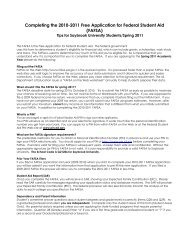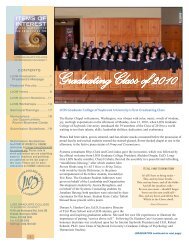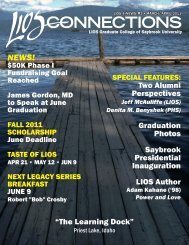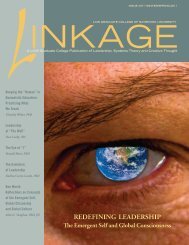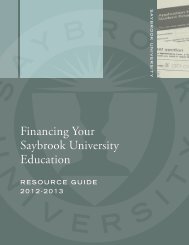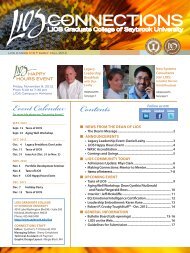A journal of creative thought and feeling published by LIOS ...
A journal of creative thought and feeling published by LIOS ...
A journal of creative thought and feeling published by LIOS ...
You also want an ePaper? Increase the reach of your titles
YUMPU automatically turns print PDFs into web optimized ePapers that Google loves.
Still lodged in the Kipling Hotel, Laura dreams <strong>of</strong> her lost life, <strong>and</strong><br />
Boorman’s camera lifts to look down on her through a revolving<br />
ceiling fan. Almost immediately, as though galvanized <strong>by</strong> that<br />
circular motion, she wakes to the sounds <strong>of</strong> people running,<br />
shouting in the street. This is Beyond Rangoon’s first formal<br />
wakeup call to take to the saving road, <strong>and</strong> Laura chases the street<br />
rally as though hastening not to a tense st<strong>and</strong><strong>of</strong>f between soldiers<br />
<strong>and</strong> political protesters, but toward some longed-for reunion.<br />
Heralding the coming <strong>of</strong> Aung San Suu Kyi (Nobel Prize-winning,<br />
heroic dissident under house arrest for years <strong>and</strong> now on trial in<br />
Burma, played <strong>by</strong> Adelle Lutz), the Burmese woman who heads<br />
the mostly youthful dissidents, a little girl shyly touches Laura’s<br />
h<strong>and</strong>, the first in a series <strong>of</strong> guiding, arming signals <strong>by</strong> children<br />
who st<strong>and</strong> in reality for the counsel <strong>of</strong>fered <strong>by</strong> her murdered son<br />
in dreams.<br />
Suu Kiy walks deliberately into the soldiers’ ranked guns, almost<br />
the graceful hostess greeting guests. Laura watches, mesmerized, as<br />
the woman’s serenely beautiful face gathers <strong>and</strong> aims the power <strong>of</strong><br />
self until she literally quakes the uniformed men out <strong>of</strong> her way.<br />
In Boorman’s Merlin-animated mise-en-scene, Suu Kiy becomes<br />
Laura’s patron goddess. St<strong>and</strong>ing in for the Arthurian lady in the<br />
lake, she opens a channel <strong>of</strong> <strong>creative</strong> energy, breaking Laura’s “curse”<br />
to turn stone into flesh-<strong>and</strong>-blood warrior.<br />
Once mothered, Laura attaches herself to an exquisitely civilized<br />
cicerone in the guise <strong>of</strong> fatherly Aung Ko, a university pr<strong>of</strong>essor<br />
imprisoned <strong>and</strong> exiled forever from teaching for his support <strong>of</strong> antigovernment<br />
students. Boorman makes<br />
us see <strong>and</strong> feel mythic resonance each<br />
time his heroine crosses a Rubicon: it’s<br />
as though the fabric <strong>of</strong> reality shivers<br />
like water, racking focus into a new,<br />
altered pattern <strong>of</strong> experience. In one<br />
eerie exchange, Laura’s head turns—<br />
almost in slow motion—to witness the<br />
old man, bent forward, Sisyphus-like,<br />
outside the passenger side <strong>of</strong> the car,<br />
laboriously pushing the stalled vehicle<br />
through a pelting rainstorm. With<br />
near-ritual precision, Laura opens<br />
her door, gets out into the heavy weather, <strong>and</strong> wordlessly adds her<br />
weight to the effort.<br />
And later on in our knight’s reanimation, she <strong>and</strong> Aung Ko careen<br />
down a forest track in that old car, closely pursued <strong>by</strong> government<br />
troops. A shot is fired, the pr<strong>of</strong>essor is hit, <strong>and</strong> Boorman’s heroine<br />
turns to look back–her rear-window view <strong>of</strong> rapidly gaining death<br />
framed through the circle <strong>of</strong> a bullet hole. Previously, Laura had<br />
gazed out impassively through car-window glass, wiped <strong>by</strong> passing,<br />
unreal reflections. But now her bell jar has been shattered <strong>by</strong> a<br />
plunge into the down-<strong>and</strong>-dirty, the ground where matters <strong>of</strong> life<br />
<strong>and</strong> death draw blood.<br />
Cast into a muddy<br />
river with her badly<br />
wounded friend,<br />
Laura swims away<br />
from the soldiers’<br />
guns; her panting<br />
grunts erupt from<br />
deep inside her. In<br />
contrast to her nearly<br />
disembodied scream<br />
when the child fell<br />
from the Buddha,<br />
these are the primal sounds <strong>of</strong> an animal fighting blindly, ruthlessly<br />
to stay alive. Baptism <strong>and</strong> resurrection intersect, exhilaratingly, in<br />
the rising line <strong>of</strong> her firm-fleshed arm as it reaches up–in Boorman’s<br />
trademark image <strong>of</strong> power born <strong>of</strong> regenerative waters–to grasp a<br />
low-hanging limb. At this moment, Laura becomes her own Lady <strong>of</strong><br />
the Lake, raising her submerged will, unsheathing the Excalibur <strong>of</strong><br />
her spirit from stone.<br />
Almost immediately, true to mythic tradition, she faces a crucial<br />
setback: thrashing to break through tangled branches at river’s<br />
edge, Laura is thrown backwards, to literally grovel in a muddy<br />
soup after she drops the locket that contains pictures <strong>of</strong> her beloved<br />
dead. Kneeling in place, clutching her funerary talisman, Boorman’s<br />
mother-healer trances out, as she does at several crucial junctures:<br />
her wonderfully molded face blanks, her eyes go flat with a dull<br />
darkness, <strong>and</strong> the flesh that lately pulsed with the desire to stay alive<br />
pales, as though her very blood had receded, stopped flowing.<br />
The sound <strong>of</strong> suffering Aung Ko’s groan<br />
labors Laura back into life; she takes<br />
renewed fire, picking up a cudgel to<br />
beat down the thicket she has despaired<br />
<strong>of</strong> escaping. As she explodes out <strong>of</strong> the<br />
foliage, she’s greeted <strong>by</strong> the sight <strong>of</strong> a<br />
little Burmese boy—he has a perfectly<br />
legitimate reason for being there, but<br />
he’s also a reflection <strong>of</strong> the lively child<br />
released in her as well as the receding<br />
ghost <strong>of</strong> her son.<br />
Director / creator Boorman “dreams”<br />
Patricia Arquette as he wants <strong>and</strong> needs his heroine to be. (In his<br />
serious-whimsical I Dreamt I Woke Up, Boorman <strong>and</strong> John Hurt,<br />
who plays the director as dreamer, exchange horrified glances at the<br />
sight <strong>and</strong> sound <strong>of</strong> an ungendered, militantly anti-magic feminist;<br />
Hurt turns desperately to his movie-making self to dem<strong>and</strong>, “Can’t<br />
you make her the way we want her to be?”) Weaving Merlin’s “spell<br />
<strong>of</strong> making” from his Excalibur, Arquette’s auteur magicks his lady<br />
Arthur into an heroic largeness that could never have been achieved<br />
simply <strong>by</strong> the actress’s gaining 25 pounds for the shoot.<br />
In the amniotic fluid <strong>of</strong> Boorman’s imagination <strong>and</strong> Burma’s many<br />
rivers, Arquette grows as performer <strong>and</strong> character to inhabit her<br />
(continued on page 31)<br />
23



